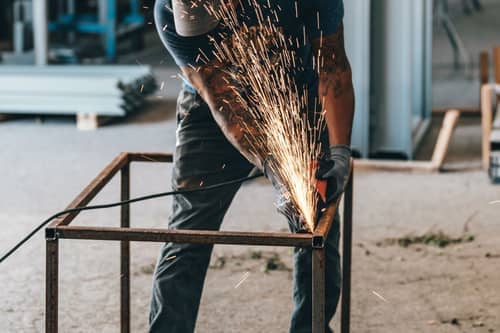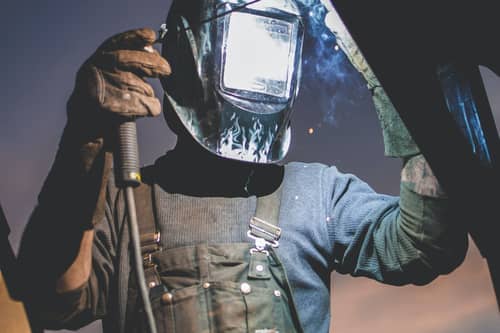Welding refers to the fusion of two or more parts by heat, pressure, or a combination of the two. Of course, that process isn’t always as simple as it sounds. We call the areas where these materials join welding joints and must follow specific procedures to create them.
Different types of welding joints demand different types of welding processes, which means you’ll need to develop a thorough understanding of welding practices to know what’s best for your project. Read this article to learn more about them.
Listed below, we’ll walk you through the different kinds of welding joints and the welds they require.
Table of Contents
What are the 5 Different Types of Welding Joints?
-
Apply for a welding degree at NEIT!
Loading…
/**/

There are five different types of welding joints as defined by the American Welding Society. They each boast unique characteristics in terms of how materials may fit together. Keep reading to learn more about each specific welding joint.
Corner Joint
Corner joint welding refers to instances in which two materials meet in the “corner” to form an L-shape. You can use corner joints to construct sheet metal parts, including frames, boxes, and similar applications.
Different weld types can include:
- Fillet weld
- Spot weld
- Square-groove weld or butt weld
- V-groove weld
- Bevel-groove weld
- U-groove weld
- J-groove weld
- Flare-V-groove weld
- Edge weld
- Corner-flange weld
Edge Joint
You can create an edge joint by placing two materials together to distribute stress. You can create several different forces using edge joints, including tensile, compression, bending, torsion, and shear. You can also use edge joints to construct tabletops or cabinets.
Different weld types can include:
- Square-groove weld
- Bevel-groove weld
- V-groove weld
- U-groove weld
- J-groove weld
- Flare-V-groove weld
- Flare-bevel-groove weld
Butt Joints
A butt joint refers to when you join two materials on the same plane and weld them together. You can use this joint type to put together piping systems or constructing chairs, cabinets, panels, and tabletops.
Butt welds are made in various ways, depending on the shape of the groove, layering, and width of the gap. The most common defects include burnthrough, porosity, cracking, or incomplete penetration.
Different weld types can include:
- Square-groove weld
- Bevel-groove weld
- V-groove weld
- U-groove weld
- J-groove weld
- Flare-V-groove weld
- Flare-bevel-groove weld
- Surfacing weld
Tee Joints
A tee joint (also known as a “t joint”) refers to when two pieces of materials intersect at a 90-degree angle, creating a “T.” Certain preparations must be made depending on certain properties like the thicknesses and weights of material used. You can use tee joints for welding a pipe or tube onto a base plate.
Different weld types can include:
- Fillet weld
- Plug weld
- (Slot weld
- Bevel-groove weld
- J-groove weld
- Flare-bevel groove
- Melt-through weld
Lap Joints
To create a lap joint, you must fuse two metal pieces in an overlapping pattern on top of each other. They are sometimes categorized as modified versions of butt welds. Welds can be made on one or both sides. You can use lap joints to patch things or join pieces that have different levels of thickness.
Different weld types can include:
- Fillet weld
- Bevel-groove weld
- Slot weld
- Spot weld
- J-groove weld
- Plug weld
- Flare-bevel-groove weld
How to Prepare Welding Joints
As mentioned, there are four basic welding processes used. There are, however, over 30 different types of welds. Different welding styles can form a specific type of welding joint.
Joint preparation refers to the different ways you can prepare metal for welding. This will help you avoid situations where you are left with improper dimensions and poor fusion.
First, you’ll want to remove all impurities such as rust, mill scale, and oxides. You can then use several different cutting methods to cut your pieces in their desired shapes.
The plasma arc cutting process is frequently used to do so, along with waterjet and laser beam cutting. Other basic cutting methods include casting, shearing, machining, forging, filing, and routing.
You can also use edge preparation, air carbon arc cutting, and gouging to prepare the joint, depending on the type of alloy you are using.
The application of cleanliness measures is critical during joint preparation. You can use acetone, alkaline cleaner, and other solvents to clean work surfaces and adjacent areas.
Welding Safety Tips

Creating welding joints can be a hazardous process. You may be exposed to electrocution, fire, explosion, burns, and electric shock. You will also be exposed to dangerous gases and fumes as well as ultraviolet radiation. Fortunately, there are ways to protect yourself.
The first step you should take to protect yourself revolves around protective wear. You can wear safety glasses, bandanas, welding jackets, helmets, welding gloves, leather aprons, and leather shoes to protect your skin and prevent your clothes from catching sparks.
START YOUR WELDING CAREER
Earn your degree in Welding Engineering Technology from NEIT and begin your new career path today!
ASSOCIATE'S DEGREE
BACHELOR'S DEGREE
FAQ
What are the 4 types of welding?
There are four main types of welding processes used across the sheet metal industry: MIG welding, TIG welding, Stick welding, and Flux Cored Arc welding.
Which type of welding is best?
While different projects will demand different kinds of welds, MIG welding is the best type of welding for beginners. These welds use a wire welding electrode, making it a semi or automatic process and the easiest to learn.
What materials do you weld?
Some of the best weld materials include low carbon mild steel, aluminum, stainless steel, and other metals.
What are the most popular types of welds?
Fillet welds remain the most common type of welding practice, with groove welds following close behind.
Check out some of our other articles to learn more about welding, weld joints, and weld types. You might be interested in:
Best Welding Schools in Rhode Island

